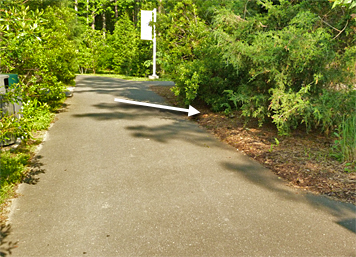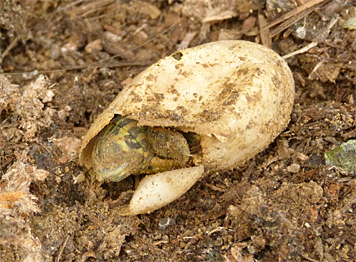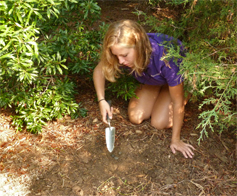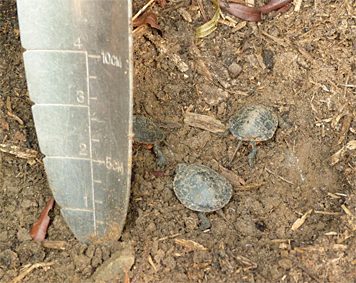Above: Female yellow-bellied slider looks to see if it’s safe to come ashore to lay eggs.
It was May. Aquatic turtles of various species were up and walking along the paths and woods of the Museum’s outdoor exhibits, in fact, they could be seen throughout the entire Museum grounds. They were looking for suitable nest sites. When looking for nest sites turtles most often choose sites alongside roads, paths or mulched planting beds, at least that’s where they’re most often observed laying eggs here at the Museum.

Three such nests were observed this past spring by either myself or Ranger Kristin. Two were Yellow-bellied Sliders and one, an Eastern Painted Turtle. One turtle was actually observed in the act of laying her eggs.
The egg-laying turtle, observed by Kristin, is well known to many of us at the Museum, a large chunk of her carapace is damaged making for easy identification wherever she wanders. She was observed dropping her eggs as Kristin sat nearby watching her. Her preference was a mulched area between two pine trees next to the Meadow in Catch the Wind. She deposited her eggs on June 7, a few weeks after the others.

The two nests that I observed were in the process of being covered up by the turtles as I came upon them. The painted turtle was first spotted by Animal Keeper Mikey as he made his rounds on the morning of May 20 near the Red Wolf Exhibit. The yellow-bellied was in Catch the Wind next to the Sailboat Pond.

Most references state that its about a 72 day, or 2.5 month, incubation period for eggs of both species, 80 days on the outside. It’s also reported that the young may overwinter in the nest. I’ve seen many examples of that here at the Museum. A young yellow-bellied or painted turtle making its way to the Wetlands in March or April is surely a turtle that overwintered in the nest, whether as an egg or hatchling (a question for another time). The ones that I find in spring still have an “egg tooth” which suggests that they had recently hatched.
It’s now September and I’m wondering what happened to the eggs in the nests. It’s well over the 72 days, 2.5 months, or even the outside number of 80 days for the eggs to hatch. So on September 3, we decide to dig up the nests and see what lies within.
Will we find shriveled-up dessicated eggs, empty nests (the turtles hatched but left no obserevable indication on the surface of their departure), perfectly intact eggs, or eggs and hatchlings that have been ravaged by ants? There’s no other way to find out but to dig!

When the adult turtles locate a suitable site to dig their nest they urinate to soften the dirt for easier digging. In our area that dirt is hard, clay-based soil. Anyone in this area who has set fence posts can attest to the soil’s unyeilding nature. This fact also makes for a very firm, almost inpenetrable, covering for the nest when it dries.




Although there were five healthy young turtles in the nest there were also a couple that had started to hatch and for some reason didn’t survive (perhaps ants), one egg was not viable, and one was partially hatched.


Even though some of the turtles didn’t survive, it was turning out to be a very rewarding day.

It was now off to the painted turtle nest in Explore the Wild. Could there be more turtles in that nest? Feeling good about finding turtles in the yellow-bellied’s nest we dove in with optimism.
Once again, careful digging so as not to harm any potential inhabitants.
There were no obvious clues as to where the actual nest was, remember, the yellow-bellied nest was equidistant between two trees, fairly easy to find. With this nest we were going from memory of three months time.
Finally…

The painted turtles were smaller than even the yellow-bellied turtles.

We only found three young painted turtles with no evidence that there had been any others in the nest. Apparently the adult had only deposited three eggs in this nest.
Why had it taken so long for these turtles to hatch? Why hadn’t they dug themselves out of the nest when they did hatch? Some of the nestlings, at least in the yellow-bellied nest, had hatched several days prior to being dug up, perhaps much earlier. It seems that the answer to those two questions may have to do with the hard clay that makes up our soil here in the Triassic Basin in which we live, and with the lack of rain this summer.
As already mentioned, when turtles dig out their nests in spring they urinate on the site to soften the dirt for digging (turtles must have very large bladders, each nest that I’ve come across has been saturated with liquid). When the clay dries after egg laying is complete it forms a hard shell around the eggs. This “hard shell” was very evident when digging up the nests above.
Turtle eggs need warmth and moisture to properly incubate. There was plenty of warmth during summer, but a definite lack of moisture. At least one of the eggs simply didn’t incubate properly or was not fertile, while the young that did hatch couldn’t dig through the hardened clay. Remember, dry clay equals hard clay. As it happened, it rained heavily a few weeks after we dug up the nests, although that may have been too late for our little turtles.
The third nest, the one next to the Sailboat Pond, sits undisturbed. I’m going to keep an eye on that nest to see if there are young that emerge from the site next spring. By the way, the Sailboat Pond nest was excavated by a yellow-bellied on May 16, several days to a week earlier than the others.
Thanks to Animal Keepers Kent and Mikey for their encouragement, patience, and knowledge, both were very helpful in answering many questions. A special thanks to Mikey for coming out to the nest site in Catch the Wind when called upon at the last minute to answer even more questions and provide assistance when we actually found turtles alive in “Chip’s” nest.
It’s been 83 days but not one painted turtle in mostly black soil I have a screen fence around the area. It’s been very warm this summer with not much rain. Should I dig them up?
If the turtles don’t emerge from the nest this season they’ll overwinter underground and dig themselves out the following spring. Depending upon where you live, that could be from March through May. Here in Durham, NC we start seeing them in March. So no, it’s not necessary to dig them up, they’ve be fine, assuming the eggs were viable.
I had a female turtle lay eggs about 5 days ago in my yard I’m going to get a mesh fence in a few days anything else needs to be done to keep them safe? I would like to keep one for myself is that possible?
Here at the museum we carry around a small container of cayenne pepper in the nesting season to sprinkle on top of any nests we find. It seems to work well to keep raccoons, fox, and other mammal predators from digging up the eggs. We haven’t used a mesh cage on the nest in quite a while.
Hello,
Yesterday I had a yellow belly slider lay eggs in my yard. What’s the best way to protect them and when would they hatch ? I’m concerned because the nest is on a little slope where people could potentially walk. I also don’t want my husband to mow over the nest. I live in NY. I do have marsh lands in my backyard. Thank you!
I would sprinkle a good amount of cayenne pepper on the surface after the female departs. It seems to do a good job of keeping mammals from digging up and eating the eggs. The eggs should hatch in about 2 months. If its late in the season the nestlings may overwinter in the underground nest emerging the following spring. I closely monitored a known nest here at the museum and was there when the turtles emerged. It was over 200 days after the eggs were deposited.
If you’re worried people may step on the nest, I think they’ll be fine. And, your husband can probably mow over it too. It’s when the young turtles emerge from the nest that’s worrisome. They’re tiny and difficult to see on pavement let alone grass. But if you keep an eye out, maybe you’ll see them dig out from the nest. Though, they’ll probably slip out and be in the water before you notice. Good luck.
Observed a yellow slider laying eggs today in Charlotte, NC, on a mulch-covered, unprotected slope beside the parking lot at work. Wild Deer, ‘possum, raccoon, geese, heron, hawks, coyote and a stray cat abound. Should I try to protect turtle’s nest (and if so how?!) or let nature take its corse? Thx
We had a yellow bellied slider lay eggs in our yard May 28th. We are pretty far from the water, so we put a wire mesh cage around the nest to prevent crows and raccoons from digging up the eggs. We’ve been keeping an eye on it to watch for the babies to pop up out of the ground. We saw that it is a three month incubation period. But now we have seen your story. So should we NOT dig up the babies since they are supposed to stay in the nest over the winter? We have had a lot of rain here. But I’m just worried about what they’re going to eat because they aren’t near the water? Thanks!
Since you have a cage over them, I recommend leaving them in the nest. Keep an eye on it. There’s still plenty of time for them to hatch. If you see hatchlings in the cage and they can’t get out, remove them and take them to the pond.
If they don’t hatch, or they hatch and remain underground (you won’t know this), leave the nest alone. They’ll stay underground until next spring (March/April) and make their way to the water as best they can.
Thank you!
My mother saw a turtle lay her eggs in her yard she then noticed the next day that ants were forming where the nest was will the ants harm the eggs please advise If there is anything she could do or if cinnamon would work
I would mark the nest with a stone, or even a small flag of some kind and wait till next March-April to see if the nestlings emerge from the nest.
If ants got into the nest, there must have been an already broken egg, in which case there’s not much you can do.
When were the eggs deposited? What part of the country do you live?
The turtles, regardless of when the eggs were deposited, will not emerge till next spring if they haven’t already.
The turtles may emerge earlier if you live south of NC or later if you live north of NC.
Thanks,
Hi Greg, I googled the question “do painted turtle eggs over winter” and who popped up 1st on the list but you! Hope all is well at MLS. LP
Yes, everything is grand here at MLS.
With all the 90 degree plus heat we’ve been having our turtles are up and out of the water laying eggs big time! Unfortunately, the raccoons are right behind them digging up the eggs as fast as the turtles can lay them.
And yes, the turtles can overwinter in the nest.
Good to hear from you!
Thanks,